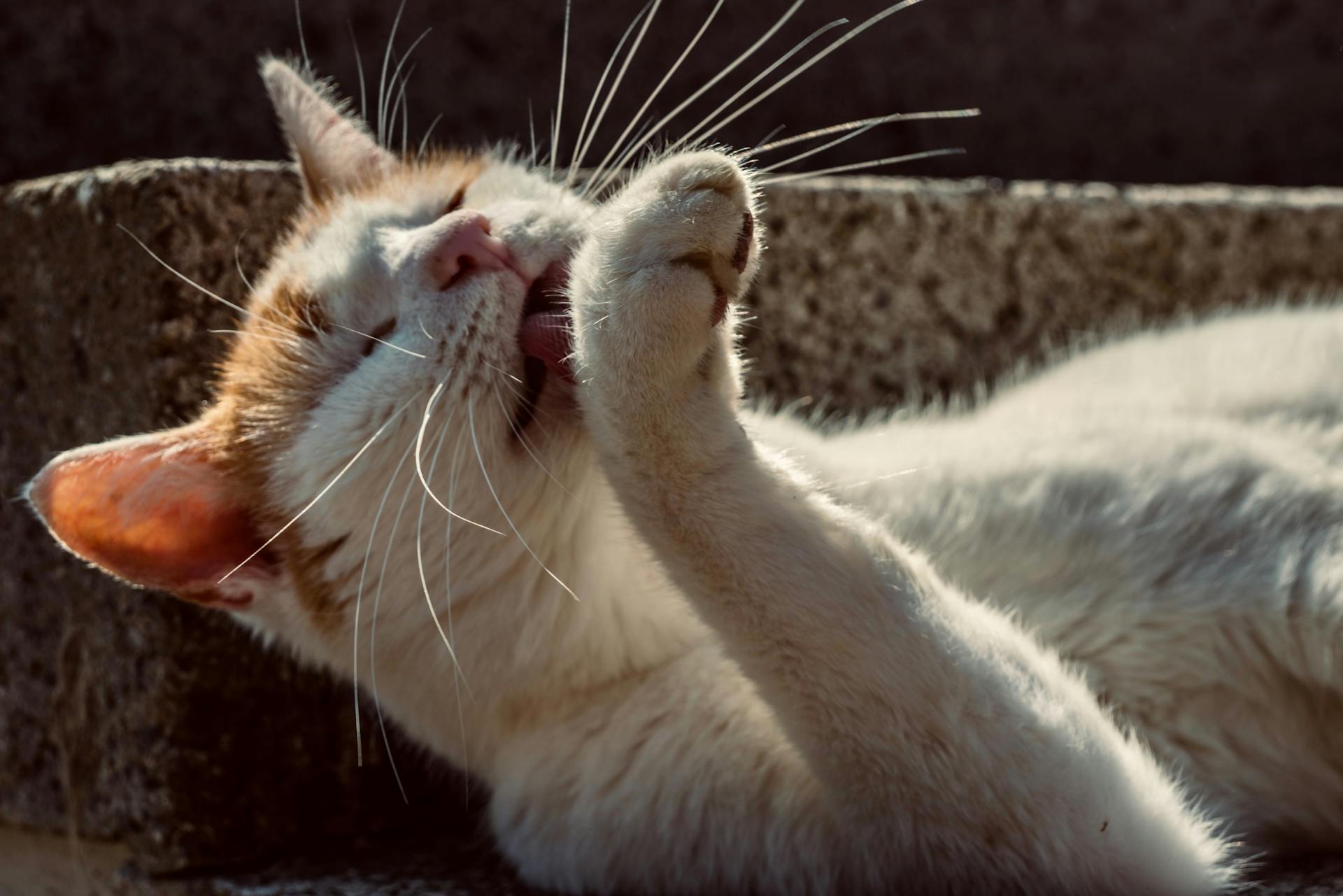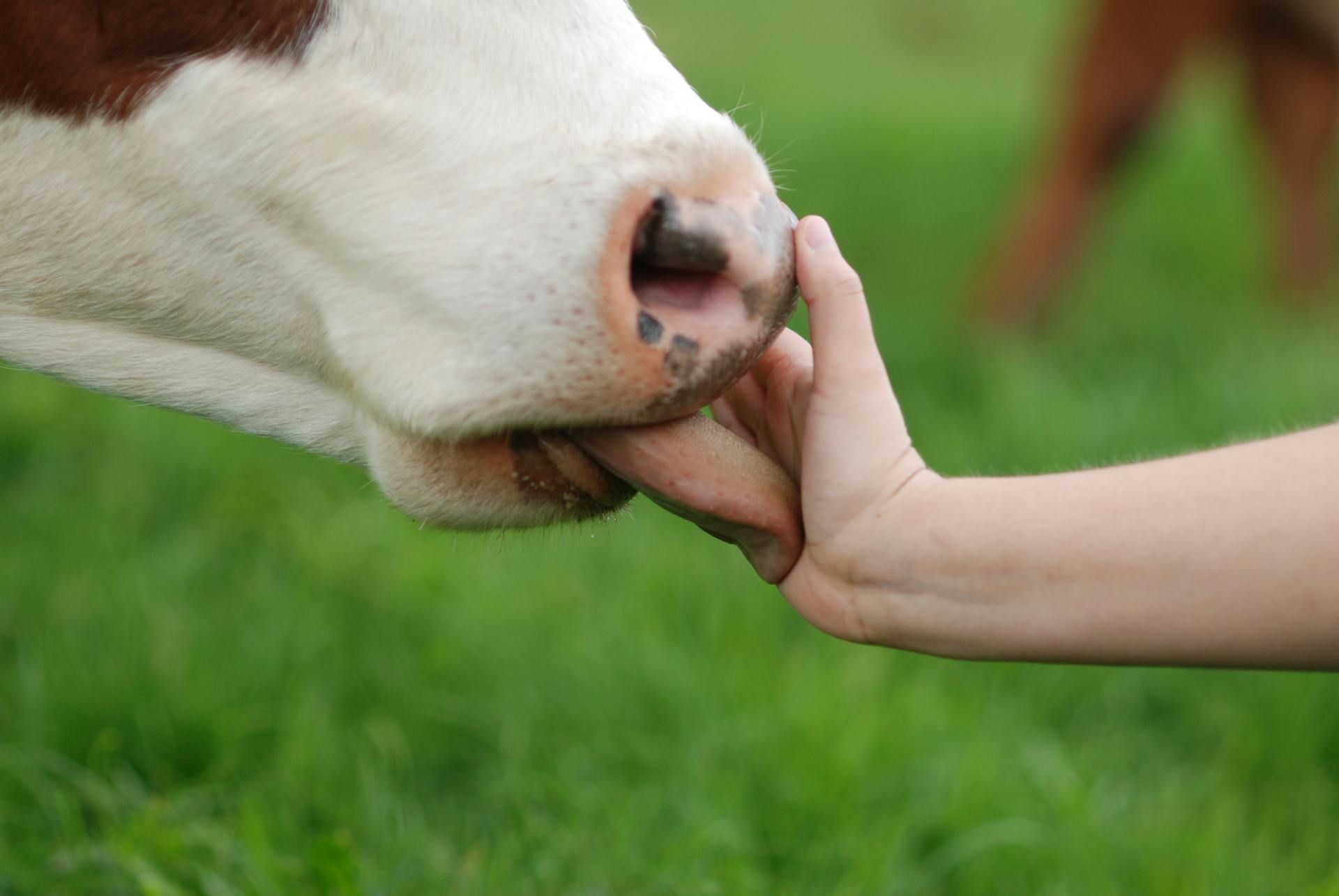
Lick granuloma is a common skin condition in dogs that can be challenging to treat, but there are home remedies that can help alleviate symptoms and promote healing.
The condition is characterized by a persistent, self-inflicted wound on the dog's skin, often caused by excessive licking, chewing, or scratching.
The wound can become infected, leading to further complications.
A lick granuloma typically appears as a hairless, red, and inflamed patch of skin, usually on the legs, chest, or belly.
To effectively treat lick granuloma at home, it's essential to identify and address the underlying cause.
Common causes include anxiety, allergies, skin irritation, and boredom.
For another approach, see: How to Treat Parasites in Dogs at Home
What Is a Lick Granuloma?
A lick granuloma is a chronic skin problem caused by excessive licking. It's a vicious cycle that can lead to angry, reddened, chronically irritated skin.
This condition is often seen in middle-aged to older, large breed dogs. They're the ones most prone to developing lick granulomas.
Male and female dogs are equally affected by lick granulomas. It's not a gender-specific issue.
Certain breeds are more susceptible to lick granulomas, including:
- Labrador Retrievers
- Doberman Pinschers
- Great Danes
- Golden Retrievers
- Boxers
- Akitas
- Dalmatians
- Irish Setters
- English Setters
- Shar-Peis
- Weimaraners
Causes and Symptoms
Lick granulomas in dogs are a complex condition with multiple causes. Excessive licking can be triggered by a variety of factors, including skin allergies or hypersensitivities, bacterial or fungal skin infections, and underlying joint pain or osteoarthritis.
Lick granulomas can also be caused by self-trauma, where a dog licks a particular area repeatedly due to mental or physical discomfort. This can lead to thickened skin or infection.
Some common underlying conditions that may trigger lick granulomas include stress, allergies, skin infections, trauma, pain, and behavioral abnormalities.
In severe cases, lick granulomas can lead to secondary bacterial or fungal skin infections and ruptured hair follicles. The condition can also cause lameness and lethargy in dogs.
Here are some common causes of lick granulomas in dogs:
- Skin allergies or hypersensitivities
- Bacterial or fungal skin infections
- Underlying joint pain or osteoarthritis
- Stress and anxiety
- Behavioral problems associated with compulsive licking
- Trauma to the skin (bruises, cuts, abrasions, etc.)
- Skin cancer
- Foreign body under the skin (grass awns or splinters)
- Neuropathies (nerve pain or sensory nerve dysfunction)
Symptoms of lick granulomas include repetitive licking, which can lead to the development of a well-defined, raised, firm, hairless, eroded to ulcerated skin lesion or skin nodule. These lesions are often red in color and wet, as saliva and serum leaking from the skin do not allow them to dry.
Diagnosis and Testing
A veterinarian's examination is the first step in diagnosing a lick granuloma. They may recommend testing to determine why your dog is licking excessively.
To rule out underlying allergic issues, your vet may need to do an elimination diet or food sensitivity testing to check for food or environmental allergies or sensitivities.
Several tests may be necessary to confirm a diagnosis of lick granuloma, including skin scrapings, allergy testing, and skin cultures.
A skin biopsy may be necessary in rare cases to rule out other issues such as cancer. This is especially true if the affected skin gets thick and traditional diagnostics are not definitive.
Your vet may recommend the following tests: skin scraping, culture for ringworm, skin testing for bacterial infection, bloodwork to check for hormonal conditions, X-rays to look at the bones and joints, allergy testing for skin allergies, food-elimination test to check for food allergies, neurological testing to check for nerve disorders, orthopedic exam to check for joint pain or problems, and behavioral consult to check for psychological causes.
You might like: Acral Lick Granuloma Dog
Here are some specific tests your vet may order:
- Skin scraping: to diagnose a mite infection
- Culture for ringworm: to determine which, if any, antibiotics or antifungal medications would be best to treat your dog's lick granuloma
- Acetate test: to examine the presence of bacteria or fungus on a clear piece of tape
- Skin biopsy: to rule out skin cancer or other underlying conditions
Treatment and Management
Treatment and management of lick granuloma involves a combination of natural and conventional methods. Time and patience are required to clear up this problem.
Treatments for lick granulomas in dogs may include antibiotics, anti-inflammatory medications, and topical ointments such as steroid cream or bad-tasting medications to discourage licking. Topical antiseptic like chlorhexidine can also be used.
A wide array of conventional treatment is used to deal with this skin condition in dogs, including antibiotics, anti-inflammatory medications, and topical ointments. If the licking is a result of behavioral problems, behavioral modification medications and/or training will be given.
A common treatment for lick granuloma is the use of an Elizabethan collar to prevent further self-harm and licking. Bandages should be placed only with the guidance of your veterinarian, as covering an infected wound traps in moisture and can make the condition worse.
For your interest: Lick Granuloma vs Hotspot
Here are some common medications used to treat lick granulomas:
- Antibiotics: Cephalexin, Convenia, Simplicef
- Allergy medications: Apoquel, Zyrtec, hydroxyzine
- Antifungal: ketoconazole (oral and topical)
- Anti-inflammatory: carprofen, prednisone, Temaril-P
- Pain medication: tramadol, gabapentin
- Anti-anxiety: alprazolam, fluoxetine, clomipramine
Increasing the amount of exercise and play time your dog gets daily can help reduce licking behavior. Your vet may also recommend behavioral modification training to assist with psychological concerns such as anxiety or stress.
Behavioral Therapy and Medications
Behavioral therapy and medications may be used if there is a psychological component to your dog's licking. This can be a complex issue, but with the right approach, it's possible to help your dog overcome it.
Therapy and behavioral drugs can be effective in addressing psychogenic licking, which is when your dog's licking is caused by anxiety, stress, or other psychological factors. A minimum of 4 weeks of therapy is recommended to see significant results.
Behavior modification training is often recommended to assist with psychological concerns such as anxiety or stress. This can include increasing exercise and playtime to distract your dog from licking.

Common medications used to treat behavioral issues related to licking include tricyclic antidepressants and dopamine antagonists, like naltrexone. Prices can vary, but it's worth exploring options like generic medications or online prescriptions.
Some over-the-counter human medications can also be used to treat your dog's licking, so be sure to ask your vet about these options if you're concerned about costs. Douxo S3 wipes and mousses can also be used at home to help manage licking.
Here are some common medications used to treat skin infections and allergies, which are often underlying causes of lick granulomas:
Light Therapy
Photobiomodulation, also known as cold or low-level laser therapy, can be beneficial for some dogs in reducing pain and inflammation.
This type of therapy has been shown to be effective in aiding some dogs.
The price of photobiomodulation treatments may vary.
Home Remedies and Prevention
Preventing lick granulomas requires attention to your dog's emotional and physical health. Being aware of your dog's behavior and physical changes is key to managing the issue before it becomes serious.
To prevent lick granulomas, you need to deal with any obsessive licking at the first sign of it. Lick granulomas can develop within a matter of hours, so it's essential to be vigilant.
Developing a habit of running your hands over your dog to check for damp fur or sensitivity can help you catch the issue early. Check your dog frequently, especially down the front legs.
If your dog is hiding from you, check him frequently to ensure he isn't hiding his obsessive licking from you. Stained fur is a sure sign he's licking.
Preventing licking with bandages, T-shirts, or e-collars may be necessary to interrupt licking behavior. You can also use natural remedies like CBD oil, melatonin, and Chinese herbs to calm your dog.
Here are some natural remedies to try:
- CBD oil
- Melatonin
- Chinese herbs through a Chinese medicine practitioner
- Chamomile, valerian, and St. John's Wort
- Bach Flower Essences
Increasing exercise and reducing stress can also help prevent lick granulomas. If your dog is licking excessively due to stress or anxiety, talk to your veterinarian for pointers on how to reduce stress.
Regular veterinary exams can help catch medical conditions early and prevent secondary licking behaviors. All dogs should have an exam done by their veterinarian at least once a year.
To support healthy skin, consider adding supplements like Omega-3 fatty acids and vitamins A and E to your dog's diet. Omega-3 fatty acids, such as fish oil, can help reduce inflammation and promote healing.
Readers also liked: How to Help Dogs with Skin Allergies
Treatment of Lesions
Treating lick granuloma lesions requires a combination of wound care, pain management, and addressing the underlying cause.
To prevent further self-harm, an Elizabethan or inflatable collar is essential, especially before seeing a vet and during treatment.
A complete physical examination may help determine the underlying cause of the skin lesion, and your vet may recommend an x-ray of the limb to check for any arthritis or other bone/joint condition.
Skin testing, such as an acetate test, skin culture, skin scraping, or a skin biopsy, might be ordered to diagnose the underlying cause.
In some cases, a food trial may begin, placing your dog on a limited ingredient diet, and all other foods, including treats, must be prohibited during this time.
Common antibiotics for skin infections include Cephalexin, Convenia, and Simplicef, while common allergy medications include Apoquel, Zyrtec, and hydroxyzine.
A list of common medications prescribed for lick granulomas includes:
Treatment of the wound should take 7-14 days on average, and topical therapy with creams, wipes, or shampoos may be recommended to help with infection.
Recovery and Prevention
Recovery and Prevention is a crucial part of treating a lick granuloma. To prevent further licking and infection, it's essential to keep a protective collar on your dog, especially when they're alone or at night.
Dogs with lick granulomas require early treatment to have a better prognosis for recovery. If left untreated, continued licking can cause serious infection in the skin's underlying muscles and bones.
You can help prevent lick granulomas by being attentive to your dog's emotional and physical needs. Regular veterinary exams can catch medical conditions early, reducing the risk of secondary licking behaviors.
Here are some tips to help prevent lick granulomas:
- Interact with your dog regularly to keep him engaged and involved.
- Check your dog frequently, especially if he's hiding or licking excessively.
- Use athletic bandages or other deterrents to discourage further licking if you notice it.
- Address any underlying conditions or stressors that may be contributing to the licking behavior.
By following these tips and working with your veterinarian, you can help prevent lick granulomas and promote a healthy, happy life for your dog.
Will It Go Away on Its Own?
Lick granulomas don't heal themselves. You have to get rid of them by stopping the itch-lick cycle.
Stopping the itch-lick cycle requires getting to the root of the skin problem or infection and treating it.
The first step is to stop the infection and ensure the affected area stays clean and germ-free. This can be done by following proper wound care and hygiene practices.
For your interest: Toxocara Canis Life Cycle
Healing Time
A lick granuloma can take several months to heal, especially if a bacterial infection is present.
In most cases, it takes several months to eliminate the infection and start the healing process.
Systemic treatment is often required, which can take several months to complete.
Antibiotics may be prescribed over a course of several months, but they can also destroy good bacteria in your dog's gut, creating more health problems.
Safe, natural antibiotics can be used to fight the infection without harming your dog's gut.
On a similar theme: English Bulldog Wrinkle Infection
Recovery and Management
Recovery from a lick granuloma can be a long and frustrating process for both dogs and their owners. Most dogs have a guarded prognosis, meaning it's rarely life-threatening but can be challenging to manage.
Determining the best treatment often requires trial and error, and several visits to the vet may be necessary to find the ideal combination of treatments. This process can be time-consuming and may involve multiple attempts to find the right solution.

It's essential to keep a protective collar on your dog, especially when they're alone or at night, to prevent further licking and infecting the wound. This simple step can make a big difference in the healing process.
Lick granulomas don't heal themselves, and it's crucial to get rid of them by stopping the itch-lick cycle. This means identifying and treating the underlying skin problem or infection and changing your dog's behavior to prevent recurrence.
In most cases, a bacterial infection is the underlying cause of a serious lick granuloma, which requires systemic treatment that can take several months. This means antibiotics may be prescribed over a course of several months, but this can have unintended consequences on your dog's gut health.
A lick granuloma can take several months to heal, and it's essential to take a multi-step approach to eliminate the infection and promote healing. By addressing your dog's comfort and taking a holistic approach to treatment, you can help your dog recover from a lick granuloma.
Frequently Asked Questions
Do lick granulomas hurt dogs?
Yes, lick granulomas can cause pain and discomfort for dogs, which can also increase the risk of infection if left untreated. Understanding the causes and symptoms of lick granulomas is crucial to providing effective care for your dog.
What antibiotic is used for lick granulomas in dogs?
For secondary bacterial infections, such as lick granulomas in dogs, antibiotics like cephalosporin, amoxicillin-clavulanate, or clindamycin are commonly used. Treatment may also involve culture and sensitivity testing to determine the best antibiotic for the specific infection.
Sources
- https://www.dogsnaturallymagazine.com/licking-the-lick-granuloma/
- https://www.stortvet.com/acral-lick-granuloma-2/
- https://www.greatpetcare.com/dog-health/acral-lick-dermatitis-lick-granuloma-in-dogs/
- https://www.natural-dog-health-remedies.com/lick-granulomas.html
- https://www.petmd.com/dog/conditions/skin/acral-lick-granulomas-dogs
Featured Images: pexels.com


